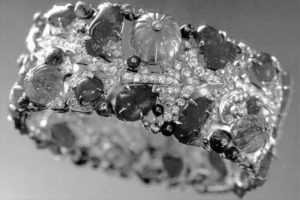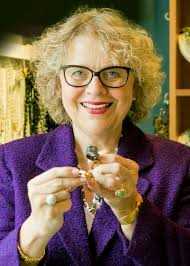Art Deco, a decidedly modern style

Art Deco, which takes its name from the International Exhibition of Decorative Arts held in Paris in 1925, is a decidedly modern style. Its peak is between the two world wars.
This movement feeds on several sources: cubism with its geometric forms, of which Georges Braque and Pablo Picasso are the most famous representatives; the Russian ballets, and their brightly colored costumes, settled in Paris after the Bolshevik Revolution; Indian art with its carved and colored stones; Egyptian art popularized following the discovery of Tutankhamen’s tomb in 1922; African art that seduces with its ebony and ivory bracelets, panthers and elephants, and even oriental art with its pagodas.
The 1920s and 1930s in Europe is the time of the Roaring Twenties. The jazz and the Charleston come from America near the Moulin Rouge and haute couture design of Coco Chanel, Poiret and many others. Living legends live side by side: Marlene Dietrich, Josephine Baker. Mistinguett. Rudolph Valentino, Maurice Chevalier, etc.
In the United States, it is the time of the prohibition, of Al Capone, the Ku Klux Klan and the crash of Wall Street, which in 1929, upsets all the West. The Great Depression sees financial markets and prices for goods and services dropping dramatically. The soup kitchens are multiplying …
The radio, often made of bakelite, offers a happy escape. The cinema is gaining popularity. A double program with filmed news costs 10 cents. Greta Garbo, Jean Harlow and Mae West symbolize the quintessence of seductive femininity, while Clark Gable, Bing Crosby and Fred Astaire thrill the hearts of many women!
Jewelery reaches the heights of elegance
It is in jewelery that Art Deco reaches the peaks of elegance. The big names still remain familiar today: Cartier, Boucheron, Lalique, Van Cleef & amp; Arpels. These artists satisfy the demand of the new rich, these industrialists of the reconstruction of Europe and the development of America. Several great jewelers of Place Vendôme then open their shop in New York.

Women want to assert their independence
After contributing to the war effort, women want to assert their independence. The wearing of pants (introduced by Chanel), the fashion of short hair to the boy, the privilege of smoking in public and the influence of suffragette movement prove it. Elizabeth Arden and Helena Rubenstein take advantage of the desire to look beautiful, sensual and young. In the 1930s, women get tired of the masculine look. Influenced by American actresses, they wear soft hats and long hair again.
The dresses are finely draped at the hips and generously neckline, sleeveless, largely uncovering the neck and wrists that only ask to adorn themselves with jewelry. Long earrings (dangle earrings) are state of the art! The beaded or hard stone necklaces (worn to the waist for the hi-hat and back to the lofts in the back), the brightly colored pendants and geometric shapes, the epaulets (hanging pins that the one bites on one shoulder), the headbands and necklaces transformable into bracelets, embellish the silhouettes. The transformation from one type of jewel to another was also very fashionable in Art Deco.
The wristwatch, first worn by the officers, is becoming more and more fashionable. Women exhibit jewelry watches, in fact bracelets decorated watches sometimes nicely hidden. At a party, the man being responsible for the moment of return, the lady had to read the time discreetly!
The Art Deco jewel, rich in innovation

The most important innovation in the jewelery field has been the clip, also known as the “pin-clip” or “duet”. In pairs, the clips adorn each side of a dress or the top of
shoes. The clip is worn alone on a hat, the lapel of a jacket, or applied to a bag or even a bracelet. Assembled by a special hinge, the two parts form a single pin more imposing.
Note the innovation of the invisible seam by Van Cleef & amp; Arpels in the 1930s. Carefully calibrated stones are juxtaposed against each other in an invisible gold net seen from the front. The work is done entirely on the back of the jewel.
In Art Deco, we appreciate white metals: platinum, white gold, silver, chrome and steel. On the background of diamonds and even rhinestones stones often carved (fruits, beetles, etc.) and contrasting colors reveal astonishing effects: ruby, emerald, sapphire, onyx, the. Pis lazuli, agate, coral, jade, ivory. Synthetic stones, glass and bakelite are also in the spotlight.
The famous Bakelite is a material invented by Dr. Leo Baekeland in 1909, by accident, it creates a resin that can be molded into jewelry. The latter, black, brown, red, orange and yellow are now sought after, because they symbolize all the nostalgia of an era.

The popular objects, real jewels set with stones and made by jewelers with precious metals such as gold or silver, are: the compact, the minaudière, the cigarette holder, the cigarette cases (smoking in public makes ” chic, be chic, it’s the ultimate compliment!), little boxes and evening bags for the new rich people’s worldly life. Today, we find these magnificent creations in museums and major collections.
Since the 1920s, Coco Chanel and Elsa Schiaparelli have been offering fancy jewelery to accompany their haute couture collections. This type of jewel made of white metal, rhinestones (glass) and plastic opens a new niche. The motifs are inspired by precious jewels, humorous themes or the speed that is venerated (automobile, greyhound, gazelle).
In the 1930s, the platinum-diamond alliance was embraced for its “all-white look”. We also love massive, bold and geometric jewelry without decorative additions.
At the end of this decade the United States emerge from the Great Depression, war rages in Europe and France is no longer the center of the world jewelry. The crowned heads and the European nobility lose influence in a changing world. The Second World War closes forever the chapter of the importance of royalties in the history of jewelry. The era of Hollywood stars is needed!
In Quebec, Henry Birks et fils maintained its status as leader and took one of the most opportune decisions in its history: the creation of the now famous blue box, decorated with two inverted B’s and the lion’s family coat of arms. At the same time, Dupuis and brothers in Montreal employs 1,500 people, while Paquet and Laliberté stores dress the beautiful ladies of Quebec.

